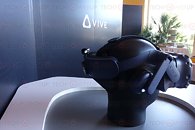Tuesday, January 9th 2018

HTC Announces The VIVE Pro VR Headset
HTC took to CES 2018 to announce the next iteration in immersive VR with the VIVE Pro VR headset. The new Vive Pro boasts of much increased per-eye resolution (1440 x 1600 per eye compared to the original VIVE's 1080 x 1200 pixels). Furthermore, the new Vive Pro abandons the 90 Hz LCD technology and makes the move to AMOLED technology for its panels, which keep the 90 Hz refresh rate of the LCD screens with much higher pixel density and image fidelity.As time passed since the first HTC Vive, so as processing power in our graphics cards increased; however, the new VIVE Pro boasts of 78% higher pixel count when compared to the first-generation VR headsets, which will likely bring most modern GPUs to their knees while attempting to deliver the ideal 90 FPS to the displays. An improved design and ergonomics also make their appearance, as does the integration of headphones, which carry Hi-Rez certification and a built-in amplifier to give your VR worlds that sorely needed extra "oompf".
As an added feature, HTC is also releasing later this years a wireless adapter solution for its VIVE Pro headset, which makes use of WiGig technology to wirelessly transmit information between your computer and the headset over a 60 GHz band - such a frequency is possible due to the short distance between your processing plant (ie, your PC) and your VR headset.HTC said that the Vive Pro would be available later this quarter as an upgrade kit for existing Vive owners. The new headset will also be available as a full kit, presumably with the integration of Valve's Steam VR Tracking 2.0 base stations, later this year. HTC didn't announce pricing.
Sources:
HTC, via Tom's Hardware, Thanks @ xkm1948!
As an added feature, HTC is also releasing later this years a wireless adapter solution for its VIVE Pro headset, which makes use of WiGig technology to wirelessly transmit information between your computer and the headset over a 60 GHz band - such a frequency is possible due to the short distance between your processing plant (ie, your PC) and your VR headset.HTC said that the Vive Pro would be available later this quarter as an upgrade kit for existing Vive owners. The new headset will also be available as a full kit, presumably with the integration of Valve's Steam VR Tracking 2.0 base stations, later this year. HTC didn't announce pricing.







10 Comments on HTC Announces The VIVE Pro VR Headset
We're talking about 2880x1600@90Hz (~415MP/s*), while 2560x1440p@144Hz (~531MP/s) is the deal of yesterday and this year we march to 4K120+Hz (995+MP/s). Sure, you will need a very high-en computer to drive this, but of course Oculus/Vive was also priced for a second top VGA at the beginning and this, VR is only a secondary display to a PC.
* - MegaPixel/second
Small error there, the Vive already uses AMOLED panels.
@Kohl Baas, you are missing the fact that VR rendering always need to be higher than the native resolution due to the distortion correction. The Vive's default render target is 3024x1680 (1.4x in each dimension), while Rift CV1 used to have 2700x1600 default render target, and have switched to 2664x1586 in later SDK version, AFAIK. Even at these resolutions, you still need to further crank up supersampling in order to get sharp, crisp image, applying at least another 1.3-1.4x in each dimension (as far as 2.0x for some games, UE4-based mostly). And you need to maintain 90fps at minimum! In that scenario, we're talking 2160x1200x1.4x1.4x1.4x1.4@90Hz = 896 MP/s. The GTX1080 handles most games without issues in that mode.
Your comparison to flat monitor gaming isn't applicable, because VRR techs allow for fps dips to 60fps and below without ruining the experience (unless you're playing competitively, I suppose). VR is and will remain the most graphically demanding load for GPUs in the decades to come and will be the driver for innovation in (and will be dragged back by) GPU, interface and wireless technologies (among others like haptics, ergonomics, brain-computer interfaces, etc.).
The Vive Pro is said to have the exact same system requirements as the original Vive, which means they are either setting lower render target, using some form of fixed foveation or using other tricks and optimizations.
Just for reference, the current Pimax 8K prototype (which has a pair of 4k screens but receives just 2.5k signal for each, then upscales) has a render rate (including the default supersampling and @80Hz) of... 1741MP/s. Good luck with that ;)
Also AMD GPU usually performs not so good in VR due to heavy utilization of DX11 based Unity VR engine. Hence my joke of Vega128.
:slap::laugh:
Vive has a long way to go. Couldnt find any information on the FOV of the new vive either, but if its similar to the current headset thats pretty damn poor. Higher fov will improve the immersion over higher resolution for that headset in my opinion.